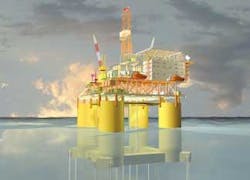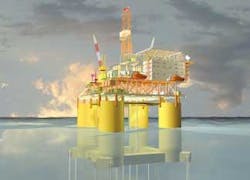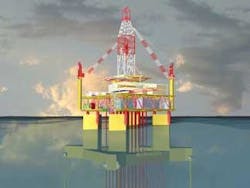Extended TLP provides major weight savings for large topsides payloads
Nick Terdre
Contributing Editor
ABB has made an impact on the deep-water sector with its new extended TLP (ETLP) concept. The company already has three orders under its belt, two for a major operator in West Africa and one for ConocoPhillips' Magnolia development in the Gulf of Mexico.
The ETLP is set to achieve a rapid transition from conception to reality. According to Vice President Chris Braithwaite, it was proposed in the company in June 1999, and the first platform is due to be installed on the field and ready for operation before the end of this year.
ABB is working on studies for field operators in the GoM, the Asia-Pacific region, and off West Africa. Braithwaite does not expect any further awards to be made this year.
The ETLP development builds on ABB's TLP track record. ABB's involvement goes back to Conoco's Jolliet TLP that was installed in the Gulf of Mexico in 1989. The company's TLP projects also include Auger, Mars, Ram/Powell, Ursa, Marlin, and Brutus in the Gulf of Mexico.
Plumbing new depths
The first TLP, Conoco's Hutton, was installed in 145 m of water. When the Magnolia platform is tethered in place next year in 1,435 m, the technology will have been extended over 20 years to cope with depths almost 10 times the original. The Magnolia installation will be the deepest yet for this type of floater. Meanwhile, ABB is confident that the ETLP design can be extended to operate in depths of 6,000 ft and more, according to Braithwaite.
Compared with other types of floaters, such as FPSOs and semisubmersible platforms, TLPs offer an increased stability that provides the advantage of dry wellheads. As the depth increases, however, the amount and weight of steel required to tether a platform also increase, to the point where the concept, without adaptation, eventually becomes uncompetitive.
null
The ETLP design represents a successful solution to the challenge of providing an acceptable topsides payload while maintaining the overall weight within acceptable limits, according to Braithwaite. Compared with a conventional TLP design, it supports the same topsides payload with a 40% reduction in hull and deck weight. In other words, the efficiency rating – the ratio of topsides payload to hull and deck steel weight – has been increased to 1.15:1, compared with the typical 0.81:1 for a conventional design. The major novelty in the ETLP is a radically redesigned hull in which the columns are located closer to the center, while anchorage capability remains unchanged due to the use of pontoon extensions to which the tendons are attached.
The hull's steel requirement has also been reduced by designing the hull with only the stability it needs once installed. The stability need is greater during installation – when it is being ballasted down for attachment to the pre-installed tendon mooring system. The additional stability is provided by fitting four temporary stability modules to the platform. The modules are watertight compartments placed above the pontoon extensions and out-board of the columns to provide an increased water-plane area during offloading. Once the platform is fully installed, the modules are removed and can be reused.
Two of the three ETLP units ordered from ABB are surface wellhead platforms that will export their production to an external processing unit. One advantage of this concept is that, given the relatively short detailed design/construction period required for the ETLP, it can be installed and some wells drilled prior to the arrival of the processing unit and start-up. The third ETLP unit has full production capability onboard.
High riser capacity
The concept also offers the benefit of accommodating a large number of risers. This again meets the needs of operators in regions like West Africa, where the large size of many deepwater discoveries makes possible a high level of production. One of the units designed by ABB will house 36 wells – the largest number on a modern TLP, according to Braithwaite, and twice what rival TLP designs could accommodate. Another unit will house 31 wells and have a further 23 subsea wells tied back to it. Both these units will have oil production capacity of 250,000 b/d. They will be installed in water depths of 1,250 m and 1,175 m respectively.
For regions like West Africa, where local resources are not as abundant, the ETLP, unlike the spar concept, also offers the advantage that hull and deck mating and platform commissioning can be carried out at quayside. The completed platform is then transported to the field, where a minimum of commissioning remains to be done. The time from installation to start of drilling can be reduced to less than a month.
null
Magnolia assignment
For ConocoPhillips' Magnolia development in the Gulf of Mexico, ABB has been awarded a contract for design, procurement, project management, and construction services for the ETLP hull and associated systems. The platform, which is relatively small, will have eight wells and production capacity of 50,000 b/d of oil and 150 MMcf/d of gas.
Hull construction, which was contracted to Samsung Heavy Industries in Korea, is expected to be complete in less than 12 months, according to ConocoPhillips. First steel was cut last January. The hull will be dry-towed to the Gulf of Mexico and mated with the topsides, which are under construction at Gulf Marine Fabricator, at a port near Corpus Christi, Texas. The platform will be fully integrated and commissioned dockside. It will be wet-towed to the field and installed in summer 2004. Start-up is scheduled for 4Q 2004. Once fully operational, the platform will have a payload of nearly 19,000 metric tons.
Magnolia will feature the first application of stepped tendons, the diameter of which tapers in stages from bottom to top, thus reducing in-water weight. Composite materials were also considered for the tendons. They will, however, be required when designing for depths beyond 6,000 ft, as the weight of steel tendons would be excessive, according to Braithwaite.
ABB is working with a composite designer on the development of composite tendons, though technical challenges remain.


